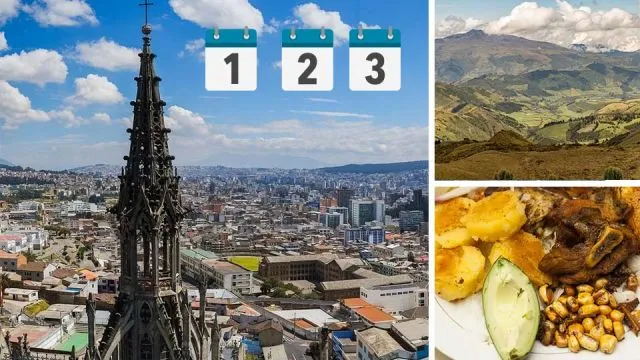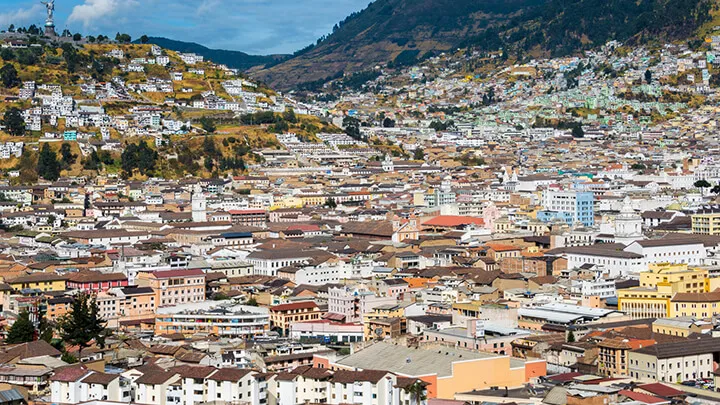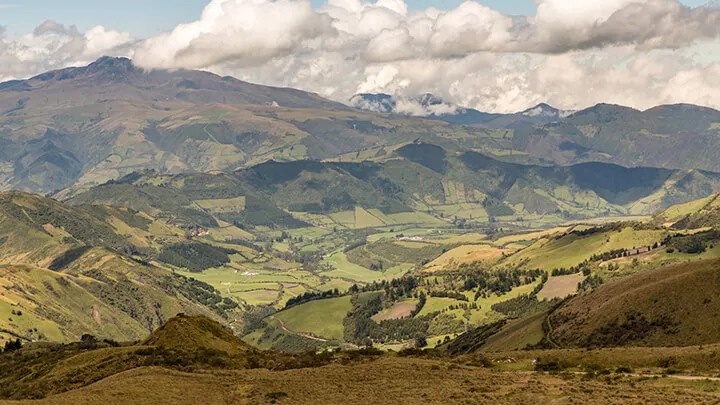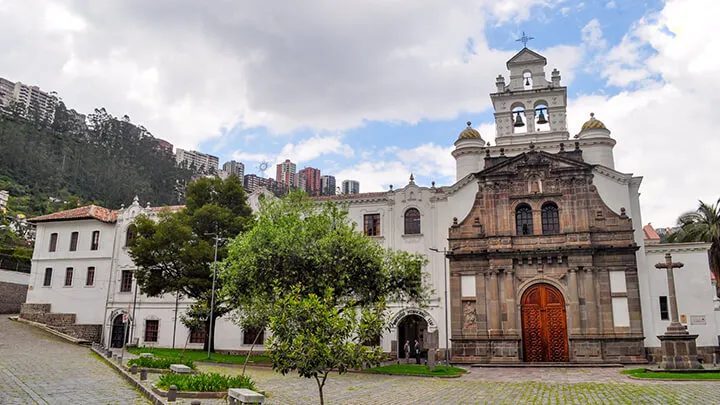
Compact little Ecuador packs a lot into a small space, and the country’s capital Quito is the perfect launching pad for an Andean adventure. Located right in the middle of the country, Quito offers easy access to Ecuador’s trio of climates: the mountains, the beaches and the jungle. While most travelers are eager to speed past the city in favor of the adventures beyond, it would be a mistake to not give Quito a few days of your time. Once you get to know the city, you won’t want to leave. So, let me introduce you to Quito in just 72 hours.
Day 1: Colonial Center

Quito’s historic center is often regarded as the best preserved colonial city anywhere in the Western Hemisphere, and is the perfect place to start your Ecuadorian adventure. Along with Krakow, Poland, Quito’s center was the first city to be added to UNESCO’s World Heritage Site list way back in 1978. It’s no surprise Quito was UNESCO’s starting point: the colonial center is a time warp from another era. Kids play in the winding cobbled streets, washing flutters from the windows above, and shoe-shiners ply their trade in leafy plazas ringed by coffee shops oozing with the aroma of caffeine.
I’ve always argued the colonial center is best explored without a map or plan. There’s a real delight that comes from meandering through the maze of streets, peeking around each corner to see what surprises await you. Having said that, there are a few highlights you won’t want to miss. A good starting point is Independence Square. Commonly referred to simply as Plaza Grande, this large open space is surrounded by coffee shops that are good for a light breakfast or caffeine break. It’s also home to Carondelet Palace, the presidential residency.
Free tours are available throughout the day, you just have to book ahead. I’d recommend booking an afternoon tour in the morning from the small booth to the side of the palace front. Also remember that every Monday at 11 a.m., it’s tradition for Ecuador’s president to make a brief appearance on the palace balcony, where the head of state waves at the crowds below. It’s a great photo opportunity, especially because it’s accompanied by the heavily ritualized changing of the guard. During the president’s appearance, soldiers in bright blue, white and red Napoleonic-era uniforms march around the plaza, brandishing bamboo polearms. It’s quite the show, and best of all: it’s free!
From the plaza, head a few blocks down to Iglesia de La Compania de Jesus for its lavish gold interior. The nearby El Sagrario is also worth a peek. For museums, consider a visit to Casa de Sucre, the former home of 19th Century independence fighter Marshal Antonio Jose de Sucre. Further to the southwest is the pleasant Iglesia de San Francisco, which can be found on the plaza of the same name. The plaza itself is the real attraction here. Head through the coffee shop in front of the church to the cavernous restaurant/tourist shop below for its intriguing indigenous art. Along with masks and Kichwa outfits, they also have a large collection of surprisingly sexualized ceramic figurines, depicting acts that must have taken some serious gymnastic training.
From here, head dead south to the City Museum, a small but engaging exhibit on the city’s history. The museum itself is on the corner of Calle de la Ronda, arguably the city’s most lively street in the evenings. During the day, it’s a good spot to peruse the chocolate shops and ice-creameries. Chez Tiff is worth mentioning for its mouth watering truffles and chocolate. Across the road, Republica del Cacao is a recognized name in Ecuador, offering high-priced, high-quality chocolate to die for.
After La Ronda, you’ll want to continue heading south to El Panecillo, a 200-meter high, perfectly rounded hill that can be seen from anywhere in the city. The walk up the hill was once considered very unsafe due to a series of muggings, though nowadays there’s usually a strong police presence. If you’d rather not risk it, just fork over a few dollars for a cab to the top, where you’ll find the symbol of Quito, the Virgen del Panecillo. This angelic statue contains a museum, and has some great views. If you haven’t had lunch yet, keep an eye out for any eateries offering almuerzos (set lunches) For a dollar or two, you should be able to score a soup, main course, dessert and juice.
Next, head back north via Itchimbia, a park with nice views of El Panecillo and an interesting collection of sculptures. To cap off the day, make your way up to the northernmost end of the colonial center, to the lead-gray Basilica del Voto Nacional. Make sure to climb up the rickety ladders to the spires for some unbeatable views. Go via Calle Luis Vargas Torres, and keep an eye out for the flea market around two blocks south of the basilica.
By now, it should be time to return to La Ronda for dinner, followed by a few rounds of canelazo, a sickly sweet cinnamon/clove beverage served piping hot and laced with aguardiente (a clear alcohol made from sugar cane). It’s a favorite nightcap in this part of the world, and is perfect for those nights when the southern winds rip through Quito’s streets.
Day 2: Pichincha

Get up early on your second day and strap up your hiking boots, because you’re climbing Pichincha. Ecuador is a brilliant country for mountain climbers, and the mountain of Pichincha is the best way to get a taste for the highlands. First, get a cab or a bus up Calle Mariscal Sucre to the TeleferiQo, a sleek, modern cable car that takes you to the base of Pichincha. The ten-minute ride is breath-taking — literally; the altitude can hit some people hard.
From the base, follow the well-worn trail across the rolling hills towards the mass of jagged black rock in the distance. After a few hours you’ll reach Paso de la Muerte (Death Pass), an eroded, sandy flank that will give your ankles hell. From here, take your time winding your way up to the final ascent, where you’ll have a light scramble before reaching the peak, Rucu. On clear days you’ll be able to see the gaping crater below. Be aware that it can get surprisingly cold up here — after all, you are at 4800 meters above sea level. Watch for falling ice.
Climbing Pichincha shouldn’t take more than eight hours, and you’ll want to be back at the TeleferiQo before it shuts down around 5 p.m. (confirm the exact time with staff on the ground). You’ll have worked up an appetite, so take a cab down to Plaza Foch. Referred to by locals as “Gringolandia,” Foch as its surroundings are a grimy mix of nightclubs, travel agencies and bars aimed squarely at tourists. Amid all this is Mama Clorinda, a restaurant specializing in classic Ecuadorian cuisine. The cuy (guinea pig) is highly recommended, as is the locro (a Kichwa potato soup). Afterwards, pick your choice of bar or club. I have a soft spot for the gringo-esque Finn McCool’s Irish Pub, though across the road Beerfest often has good deals.
Day 3: The ‘Middle of the World’

For your final day in Quito, take the bus out to Mitad del Mundo (Middle of the World), a monument located on the equator (more or less). The actual location of the monument is the subject of some controversy, with some measurements suggesting it might not be exactly on the equator. The entry ticket to the monument also includes entry to a host of other attractions in the same complex, including a museum and faux colonial village. It’s a bit cheesy, but the exhibition of mountain photography is pretty good.
For more adorable Ecuadorian cheesiness, don’t miss the delightfully eccentric Inti-nan Museum, which can be found 200 meters up the road from Mitad del Mundo. Personally, I found it much more entertaining than Mitad del Mundo. On the way back, have a look at the UNASUR headquarters. Across the road, there’s a handful of roadside diners that do almuerzos, and sometimes have cuy con papas on the menu.
On the way back to town, try to go past the Parque Arqueologico Rumipamba, which offers some intriguing insights into pre-Hispanic Quito. For souvenirs, visit La Mariscal Craft Market between Reina Victoria & Juan Leon Mera.
For dinner, your best option is to make your way out to the hipster enclave of Guapulo. The steep streets are lined with restaurants that can be a little pricey by Ecuadorian standards, but have good views of the valley below. Assuming you’re staying in the colonial center, you should finish your night at one of Quito’s artisanal breweries. The established name here is Bandido Brewing, through the nearby underdog La Oficina has some serious bite with its hearty home brews. It’s also one of the only places in town where you can get a genuinely satisfying vegan pizza.
— Ryan Mallett-Outtrim

